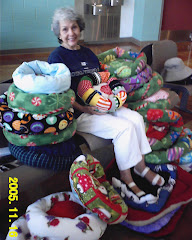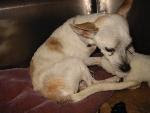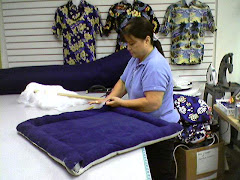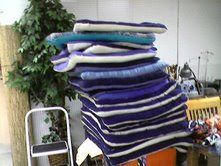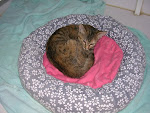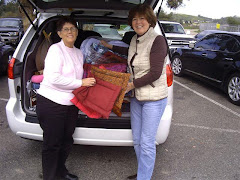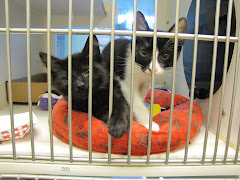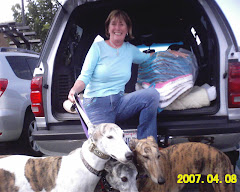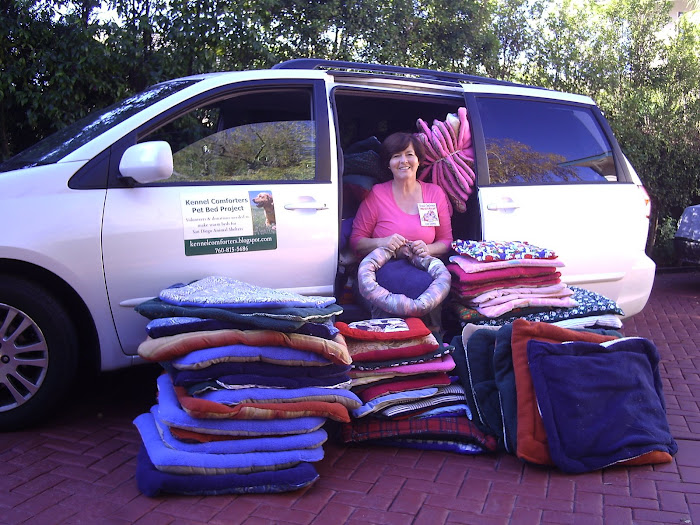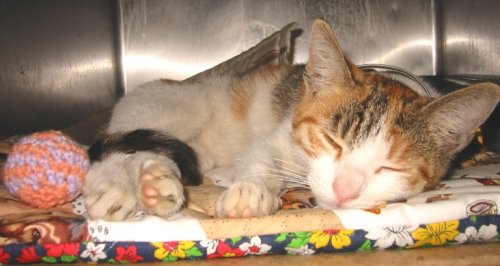

Photo A:
Dog Bed (any size square or rectangle)
Photos B & C: "Channels" sewn in to secure larger amounts of stuffing, keeps it from shifting after washing & drying.
Pin top & bottom pieces with right sides together, leaving a 7-8" opening on 2 opposite sides for stuffing later.
Pin top & bottom pieces with right sides together, leaving a 7-8" opening on 2 opposite sides for stuffing later.
Sew outer edges & round corners, don't trim excess corner fabric. Turn bed right side out.
Sew a lazy "S" through the center (see photo) this keeps stuffing from shifting during wash. Photo B shows alternate way to add "E" channels to secure polyfil during washing.
Sew two "U"-shaped channels 4-5" from the outer edges(big enough to get your hand thru for stuffing later), leaving 2 openings parallel to the 2 openings in the outer seam.
This lets you stuff the center of the bed. Sew the 2 inner openings shut. Then stuff the outer 4-5" wide channels with handfulls of polyfil stuffing, (using a PVC pipe or stick if necessary) all the way around the bed. Do not pack the polyfill too tightly, but outer "bolster" should be firm.
Zigzag stitch the final 2 openings closed, be sure to go PAST the opening & double stitch both ends of your stitching back & forth to be sure the opening is closed.
 Make the outer channels big enough for the stuffers to get their hands in & around the corners! Don't scrimp!
Make the outer channels big enough for the stuffers to get their hands in & around the corners! Don't scrimp!
Comforters for Kitties or Small Dogs ~ any size from 14"x18" to larger
 Rectangle Comforters are fast & Shelters love them!
Rectangle Comforters are fast & Shelters love them!
Sew two pieces wrong sides together, leave an opening to add batting, (looks like a pillowcase.) Turn rightside out, slide batting in (use as thick as your machine will sew), sew open end closed. Then sew 2-3" from outside edge (see photo) to secure batting during washing.
You can also make & stuff channels using Dog Bed instructions above, just a smaller size.
Round Beds ~ Don't stuff the bed till the very end!
 These are larger beds for big cats & small dogs, take a bit longer to sew, but oh are they comfortable!
These are larger beds for big cats & small dogs, take a bit longer to sew, but oh are they comfortable!
Sew two 18" circles with wrong sides together, leave an 8" opening for stuffing later.
Sew a 10"x 56" long piece together at short ends, right sides together.
Fold in half lengthwise wrong sides together. (Forms a round "tube")
 Stitch closed along folded edges, leaving an 8" opening for stuffing later.
Stitch closed along folded edges, leaving an 8" opening for stuffing later.
 Pin long side piece with the soft bottom piece pet will lay on ON TOP. Pin in 4 opposite sides then work your way around, if any extra fabric, fold the excess over to form a pleat. Now sew round pieces to long piece, lining up both 8" openings together.
Pin long side piece with the soft bottom piece pet will lay on ON TOP. Pin in 4 opposite sides then work your way around, if any extra fabric, fold the excess over to form a pleat. Now sew round pieces to long piece, lining up both 8" openings together.
The finished seam is on top of bed tucked under the side bolster. Using a serger makes this a clean seam, no fraying & can be used on outside of bed or tucked inside on top.
Stuff side bolster and bottom of bed loosely with polyfil. Don't overstuff, cats like sides that are floppy!
 Pin both 8" openings closed and zigzag stitch together.
Pin both 8" openings closed and zigzag stitch together.
Finished seam should be inside top of bed under side of bolster.
Trim any excess seam that's showing to discourage "nibbling".
 Make the outer channels big enough for the stuffers to get their hands in & around the corners! Don't scrimp!
Make the outer channels big enough for the stuffers to get their hands in & around the corners! Don't scrimp!Comforters for Kitties or Small Dogs ~ any size from 14"x18" to larger
 Rectangle Comforters are fast & Shelters love them!
Rectangle Comforters are fast & Shelters love them!Sew two pieces wrong sides together, leave an opening to add batting, (looks like a pillowcase.) Turn rightside out, slide batting in (use as thick as your machine will sew), sew open end closed. Then sew 2-3" from outside edge (see photo) to secure batting during washing.
You can also make & stuff channels using Dog Bed instructions above, just a smaller size.
Round Beds ~ Don't stuff the bed till the very end!
 These are larger beds for big cats & small dogs, take a bit longer to sew, but oh are they comfortable!
These are larger beds for big cats & small dogs, take a bit longer to sew, but oh are they comfortable!Sew two 18" circles with wrong sides together, leave an 8" opening for stuffing later.
Sew a 10"x 56" long piece together at short ends, right sides together.
Fold in half lengthwise wrong sides together. (Forms a round "tube")
 Stitch closed along folded edges, leaving an 8" opening for stuffing later.
Stitch closed along folded edges, leaving an 8" opening for stuffing later. Pin long side piece with the soft bottom piece pet will lay on ON TOP. Pin in 4 opposite sides then work your way around, if any extra fabric, fold the excess over to form a pleat. Now sew round pieces to long piece, lining up both 8" openings together.
Pin long side piece with the soft bottom piece pet will lay on ON TOP. Pin in 4 opposite sides then work your way around, if any extra fabric, fold the excess over to form a pleat. Now sew round pieces to long piece, lining up both 8" openings together.The finished seam is on top of bed tucked under the side bolster. Using a serger makes this a clean seam, no fraying & can be used on outside of bed or tucked inside on top.
Stuff side bolster and bottom of bed loosely with polyfil. Don't overstuff, cats like sides that are floppy!
 Pin both 8" openings closed and zigzag stitch together.
Pin both 8" openings closed and zigzag stitch together.Finished seam should be inside top of bed under side of bolster.
Trim any excess seam that's showing to discourage "nibbling".





